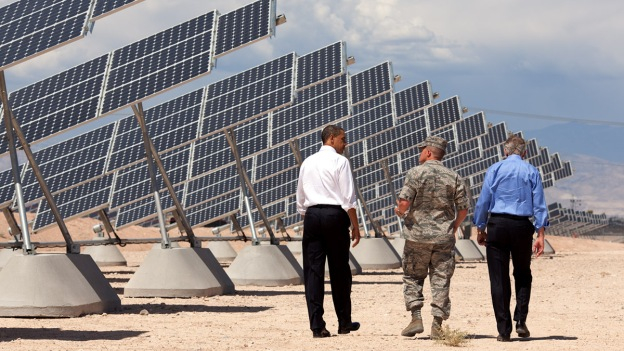“Better safe than sorry.”
Many people take this line to heart, especially if the environment is at risk. Precautionary measures such as subsidizing clean energy should not wait for scientific verification, and economic costs should not get in the way. After all, who wants to be sorry?
“No one” is the easy answer, especially when someone else pays the bill.
As we continue to pile precautionary energy policies onto a struggling economy, we may bump into an inconvenient truth. Publicly supporting clean energy can damage our economy and environment. That’s not precautionary – that’s risky!
When regulations go too far, they harm both our economy and environment. A recent peer-reviewed article in the Journal of Economic Growth estimated that, except for such historically onerous regulations, each American could now enjoy an extra $100,000 in his or her pocket.[1]
Focusing on energy policy, research for an upcoming conference at the George W. Bush Institute shows that GDP can decrease by over 0.4% for every $100 billion that regulations and subsidies redirect to “clean energy.” If we continue this rate of inefficiency, the next generation of Americans may realize incomes more like those in Italy than the United States – a shortfall of over $15,000 per capita in today’s dollars.
What’s more, energy regulations that promise to save our planet may instead be harming Mother Nature. The environment and economy do better when people make more from less. This common sense observation enjoys support from researchers such as Alan Krueger, recent Chair of the President’s Council of Economic Advisers. Krueger and others find evidence that economic growth and environmental quality can, and oftentimes do, advance in tandem
While scholarship like this suggests that competitive markets could be the best protection against economic and environmental peril, energy policy seems to have a mind of its own. Consider the White House’s recently released Climate Action Plan, which promises to tighten restrictions on new and existing power plant emissions while centrally directing more taxpayer resources to clean energy projects. Despite the spotty record of government energy investments, President Barack Obama called on “all nations” to increasingly serve energy demands “from clean sources like wind and solar power.”[2]
This paradoxical lack of precaution may be coming home to roost. America’s surge in oil and natural gas production puts the country in an enviable position to sell excess supplies abroad. Regulatory burdens may be extinguishing this opportunity. Oil exports have essentially been banned since the 1970s and natural gas exports are limited by the Department of Energy’s delay in approving the construction of export terminals. Never mind that increased supply of natural gas worldwide could reduce carbon emissions while delivering a powerful return to the U.S. economy.
Energy regulation at the state level may also be taking a considerable toll. Both New York and Pennsylvania sit atop the Marcellus Shale, a bedrock that holds an estimated 500 trillion cubic feet of natural gas. Pennsylvania moved quickly to unlock this resource and saw per-capita incomes increase by as much as 19% from 2007-2011 in drilling-intensive counties.[3]
New York instead swallowed the keys by implementing what is now a three-year moratorium on hydraulic fracturing. Lifting this ban could let area residents and workers enjoy income gains of 15% over the next four years,[4] adding upwards of $30,000 to a family of four.[5]
Historically, the U.S. economy has shown a remarkable resilience, quickly bouncing back after even sharp recessions. Four years into the current recovery,[6] however, the American economy remains stuck below its impressive long-term growth trend. Recent research from the University of Chicago points an authoritative finger at increased labor market distortions. Energy regulations in the name of precaution may also be contributing to this malaise, doing more to cool our economy than our planet.
Dino Falaschetti, Ph.D., and Matthew Denhart are research fellows of the George W. Bush Institute. Falaschetti also serves as executive director of the Property and Environment Research Center in Bozeman, MT.
[1] Dawson, John W. and John J. Seater (2013). Federal regulation and aggregate economic growth. Journal of Economic Growth, 18, 137-77. Dawson and Seater estimate a GDP loss of $40 trillion which, if distributed evenly across a population of over 300 million, translates into over $100,000 per person!
[2] The Guardian (2013). Barack Obama’s Berlin Speech – full text, June 19. Accessed June 20, 2013, at http://www.guardian.co.uk/world/2013/jun/19/barack-obama-berlin-speech-full-text.
[3] Source: Furchtgott-Roth’s Manhattan Institute study.
[4] http://www.manhattan-institute.org/html/gpr_01.htm#.UipOF8bkvb8
[5] The World Bank (http://data.worldbank.org/indicator/NY.GDP.PCAP.CD) reports 2012 per capita income for Americans as $49,965. A 15% increase in this level equals $7,495. Multiplying almost $7,500 per capita by four equals almost $30,000.
[6] NBER dates the end of the Great Recession as June 2009. http://www.nber.org/cycles.html
To view this article, visit Forbes.com.




